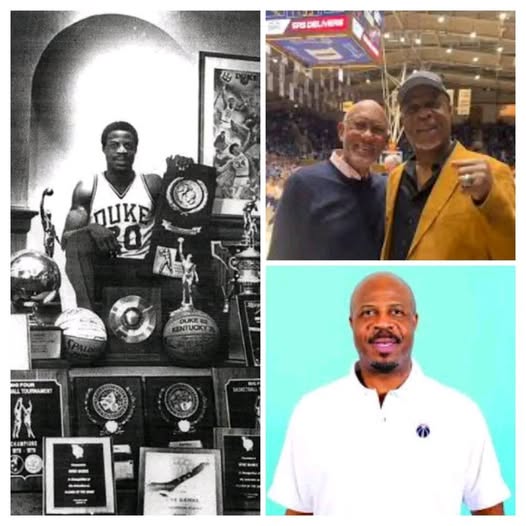Before the championship banners were raised high into the rafters at Cameron Indoor Stadium, before the legendary names like Christian Laettner, Grant Hill, and Zion Williamson etched their legacies into Duke lore, and long before Mike Krzyzewski’s 1,200-plus wins and five national titles became synonymous with greatness, there was a man who laid the foundation. A man who bled Duke blue before it became fashionable. A man whose fingerprints are still visible in the architecture of the program’s success, yet whose name is rarely spoken in reverent tones. He built the Brotherhood—but he was left behind. This is the story of the forgotten legend who made Duke great.
In the late 1970s, when Duke basketball was still searching for its identity, a brash, tenacious guard from the Bronx named Jim Spanarkel arrived on campus. He wasn’t flashy, and he didn’t play above the rim. What he brought instead was an unwavering commitment to excellence and an iron will to win. Paired with head coach Bill Foster, Spanarkel helped usher in a new era, guiding Duke to its first Final Four in decades. He became the first Blue Devil to score 2,000 career points. But even then, recognition was fleeting. While others from that team eventually received coaching offers, broadcasting gigs, and invitations back to the program, Spanarkel drifted quietly into the background.
Before him, Duke was a respectable program, but far from a powerhouse. Under Foster, and largely fueled by Spanarkel’s leadership on the court and relentless drive off it, the Blue Devils began to believe. They toppled mighty Kentucky in the 1978 NCAA Tournament and came within a hair’s breadth of a national title, losing to Jack Givens and the Wildcats in the championship game. That season changed the culture of Duke basketball—it taught a new generation of Blue Devils that they belonged on the sport’s biggest stage. Spanarkel’s performance that year—both as a scorer and a leader—remains one of the most impactful single seasons in program history.
Yet, history is not always kind to its early architects. In the years that followed, as the coaching carousel spun and Krzyzewski eventually took the reins in 1980, Spanarkel’s era began to fade from memory. The glitz and glamor of future stars, the ESPN highlights, and the “one-and-done” phenoms took center stage. The phrase “The Brotherhood” became a recruiting tool, a family brand that players like J.J. Redick, Nolan Smith, and Tyus Jones would proudly embrace. But few realized that the roots of that brotherhood had been planted decades earlier by a gritty guard from New Jersey who played without ego and without expectation of praise.
It wasn’t just Spanarkel’s numbers—though they were extraordinary—it was how he played. Every practice was a war. Every possession, a chance to dominate. He challenged teammates, held himself to a brutal standard, and took every loss personally. That ethos, that culture of relentless accountability, became the DNA of Duke basketball. It was passed on not through glossy highlight tapes, but through legacy. The way the freshman looked up to the upperclassman. The way the jersey meant something. And before Krzyzewski built his empire, it was Spanarkel who taught his peers what wearing Duke across your chest truly meant.
There was a moment—quiet but telling—that revealed the institutional memory gap. At a Blue Devil alumni event a decade ago, names were rattled off, accomplishments heralded, and highlight clips rolled across the screens. Spanarkel’s name was mentioned only in passing. No clip. No tribute. No ceremony. A few older fans noticed. Some younger ones didn’t know who he was. And that is perhaps the cruelest irony of building something great: when the empire finally rises, the early bricks are too often covered by polished marble.
Yet, Spanarkel never complained. He never demanded a statue or a banner or even a thank-you. He moved into broadcasting quietly and became one of the most respected voices in the NBA and college basketball scene. He still returned to Cameron occasionally, usually unnoticed by the waves of young fans clamoring for pictures with the newest Duke stars. He sat in the shadows, smiled proudly, and watched the program he helped build continue to soar.
Those close to the program know his impact. Former coach Mike Gminski, who played alongside Spanarkel, once said, “We don’t get to where we are without Jimmy. Period.” Even Coach K, in a rare moment of vulnerability during his farewell tour, acknowledged that players like Spanarkel “built the foundation that allowed us to dream bigger.” But the acknowledgments are often too late and too quiet.
Why do we forget the legends who came before the banners? Perhaps it’s human nature. We are dazzled by rings, trophies, and parades. We measure greatness in titles and highlight reels. In an era where social media determines relevance, players from a quieter, grittier era are often left behind. Yet, the fabric of every championship team includes threads pulled from past generations. The defense-first mentality. The no-excuses culture. The “next man up” philosophy. All of it has a lineage—and that lineage leads back to Spanarkel.
If Duke basketball is a cathedral, then Jim Spanarkel is one of its unheralded architects. He didn’t lay the final brick, but he drew the blueprints. He didn’t hoist the last trophy, but he taught others how to chase it. And just as the game itself has evolved—faster, flashier, more commercialized—so too has the way we remember its pioneers. It’s easier to post a dunk than to honor discipline. Easier to celebrate flash than fortitude.
But there is something noble about being the cornerstone. There is power in being the one who sets the tone, who leads without needing the spotlight, and who, years later, can look back and say: “I was there when the tide began to turn.” That is Spanarkel’s legacy—not in what he received, but in what he gave.
The Brotherhood is a beautiful concept. It connects generations, binds alumni, and gives current players a sense of purpose beyond themselves. But for it to be true, fully and authentically true, it must honor every member—not just the champions, but the challengers; not just the finishers, but the initiators. A brotherhood that forgets its founding brother is no brotherhood at all.
As Duke continues to chase titles in a post-Krzyzewski era, as new names and faces strive to carve their own legacy, it’s worth remembering the ones who came before the lights and the cameras. The ones who built the program when no one was watching. The ones who made Duke great before it was great.
Jim Spanarkel may never have his jersey retired. He may never see his name on a building or a floor. But if you look closely—at the grit in the defense, the poise in the press, the refusal to back down—you’ll still see his presence. In every charge taken, in every hard-nosed comeback, his spirit lingers.
Before the banners, there was belief. Before the dynasty, there was drive. Before the Brotherhood became a brand, it was a bond forged in sweat, struggle, and silence.



